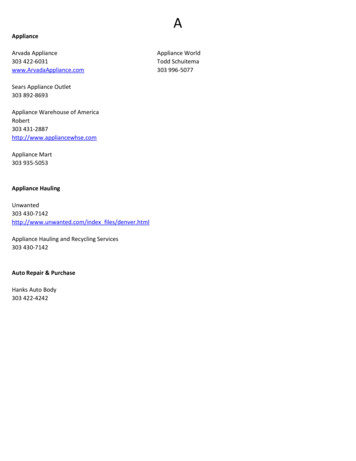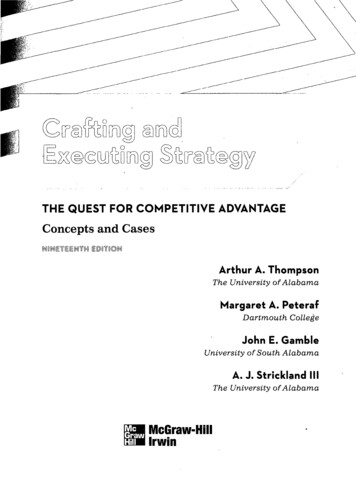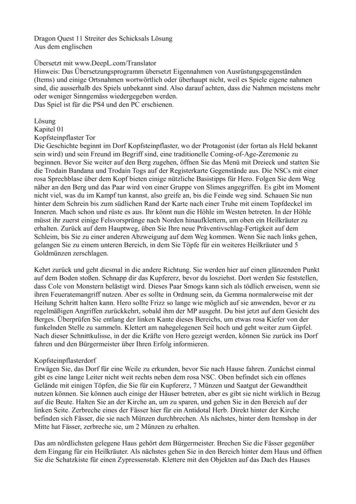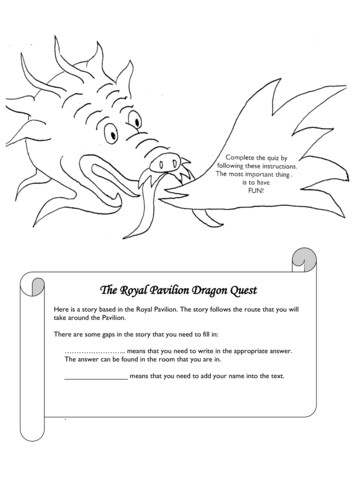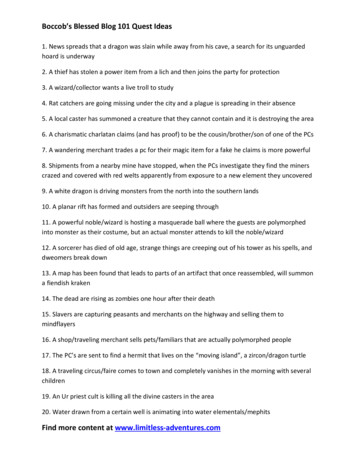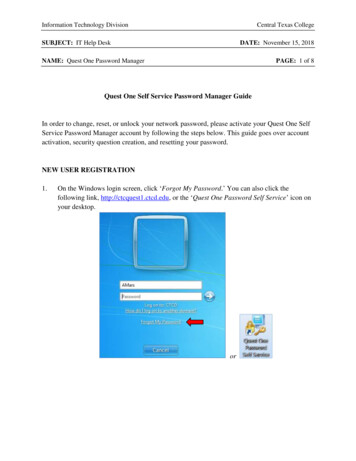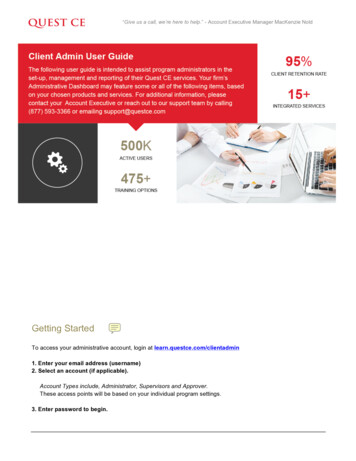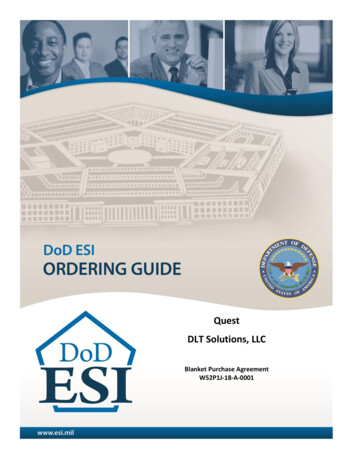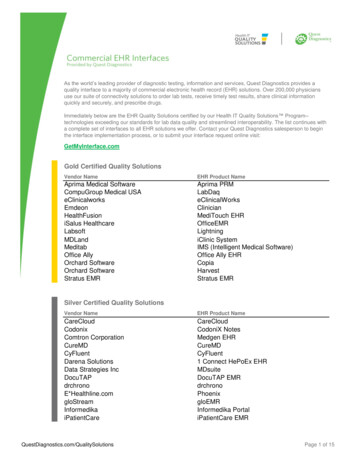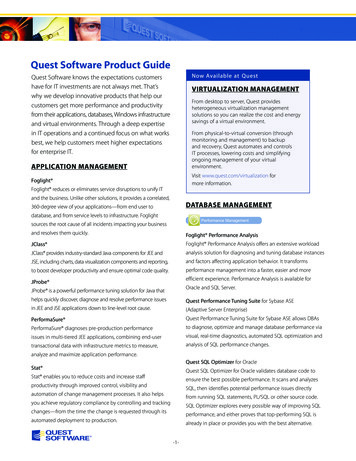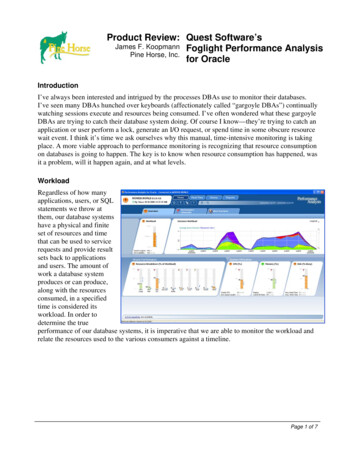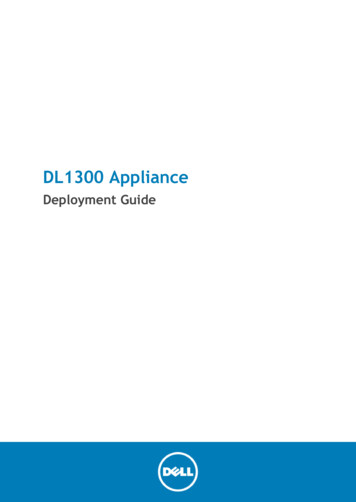
Transcription
DL1300 ApplianceDeployment Guide
Table of ContentsIntroducing your Dell DL1300. 5Dell DL1300 core technologies. 5Live Recovery. 5Universal Recovery.6True Global Deduplication.6Encryption. 6Dell DL1300 data protection features.7Dell DL1300 Core.7Dell DL1300 Smart Agent. 7Snapshot process. 7Replication — disaster recovery site or service provider.8Recovery. 8Recovery-as-a-Service. 8Virtualization and cloud. 9Dell DL1300 deployment architecture.9Other information you may need.10Installing your Dell DL1300. 12Introduction. 12Available configurations. 12Installation overview.13Installation prerequisites.13Activating Microsoft Windows Server 2012 R2 Foundation.13Network requirements. 14Recommended network infrastructure.14Setting up the hardware. 14Installing the DL1300 appliance in a rack. 14Using the system without a rack. 15Cabling the appliance. 15Connecting the Cable Management Arm (Optional). 15Turning on the DL1300 Appliance.16Initial software setup.16AppAssure Appliance Configuration Wizard. 17Configuring the network interface. 17Configuring host name and domain settings. 18Configuring SNMP settings.19Recovery and Update Utility. 19DL1300 Appliance Deployment Guide2
Rapid Appliance Self Recovery.20Creating the RASR USB key. 20Executing RASR. 21Configuring your Dell DL1300. 22Configuration overview. 22Configuring browsers to remotely access the DL1300 Core Console. 22Configuring browser settings in Internet Explorer and Chrome.23Configuring browser settings in Firefox. 23Accessing the DL1300 Core Console.23Updating trusted sites in Internet Explorer. 24Managing licenses. 24Contacting the license portal server. 25Changing a license key. 25Changing the AppAssure language manually. 25Changing the operating system language during installation.26Encrypting agent snapshot data. 27Configuring an Email server and Email notification template. 27Preparing to protect your servers. 29Protecting machines. 29Checking network connectivity. 30Checking the firewall settings. 30Checking DNS resolution. 30Teaming network adapters.31Reinstalling Broadcom Advanced Configuration Suite. 31Creating the NIC team.31Adjusting concurrent streams. 32Installing agents on clients. 32Installing agents remotely (Push).33Deploying the Agent Software when protecting a machine. 33Installing Microsoft Windows agents at the client. 34Adding an agent by using the license portal. 35Installing agents on Linux machines. 36Location of Linux agent files. 36Agent dependencies.37Installing the agent on Ubuntu. 38Installing the agent on Red Hat Enterprise Linux and CentOS. 39Installing the agent on SUSE Linux Enterprise Server. 39Common use cases.41DL1300 Appliance Deployment Guide3
Protecting machines. 41Snapshots. 41Dell DL1300 Smart Agents. 41Deploying Smart Agents. 42Step 1: Obtaining the Agent Software. 42Step 2: Install the Agent Software. 42Configuring protection jobs.43Protecting a machine. 43Recovering data. 46Recovering directories or files. 46Restoring volumes. 46Bare Metal Recovery. 48Prerequisites for performing a Bare Metal Restore for a Windows machine. 48Roadmap for performing a Bare Metal Restore for a Windows machine. 49Replicating recovery points.49Setting up your environment. 50Steps for configuring replication. 51Using virtual standby. 51Performing a one-time Hyper-V export. 52Defining one-time settings for performing a Hyper-V export. 52Performing a continuous (virtual standby) Hyper-V export.53Managing recovery points. 54Archiving data.55Creating an archive. 55Archiving to a cloud. 57Getting help. 58Finding documentation and software updates. 58Contacting Dell. 58Documentation feedback.59Index. 60DL1300 Appliance Deployment Guide4
Introducing your Dell DL1300Your Dell DL1300 combines backup and replication into a unified data protection product. It provides reliableapplication data recovery from your backups to protect virtual machines and physical machines. Your applianceis capable of handling up to terabytes of data with built-in global deduplication, compression, encryption, andreplication to specific private or public cloud infrastructure. Server applications and data can be recovered inminutes for data retention and compliance purposes.Your DL1300 supports multi-hypervisor environments on VMware vSphere, Oracle VirtualBox and MicrosoftHyper-V private and public clouds.Dell DL1300 core technologiesDell DL1300 data protection featuresDell DL1300 deployment architectureOther information you may needDell DL1300 core technologiesYour appliance combines the following technologies: Live Recovery Universal Recovery True Global Deduplication EncryptionLive RecoveryUniversal RecoveryTrue Global DeduplicationEncryptionParent topicLive RecoveryLive Recovery is instant recovery technology for VMs or servers. It gives you near-continuous access todata volumes on virtual or physical servers.DL1300 backup and replication technology records concurrent snapshots of multiple VMs or servers, providingnear instantaneous data and system protection. You can resume the use of the server by mounting the recoverypoint without waiting for a full restore to production storage.Parent topicDL1300 Appliance Deployment GuideLive Recovery5
Universal RecoveryUniversal Recovery provides unlimited machine restoration flexibility. You can restore your backups fromphysical systems to VMs, VMs to VMs, VMs to physical systems, or physical systems to physical systems, andcarry out bare metal restores to dissimilar hardware.Universal Recovery technology also accelerates cross-platform moves among virtual machines. For example,moving from VMware to Hyper-V or Hyper-V to VMware. It builds in application-level, item-level, and objectlevel recovery (individual files, folders, email, calendar items, databases, and applications).Parent topicTrue Global DeduplicationTrue Global Deduplication eliminates redundant or duplicate data by performing incremental block-levelbackups of the machines.The typical disk layout of a server consists of the operating system, application, and data. In mostenvironments, the administrators often use a common version of the server and desktop operating systemacross multiple systems for effective deployment and management. When backup is performed at the blocklevel across multiple machines, it provides a more granular view of what is in the backup and what is not,irrespective of the source. This data includes the operating system, the applications, and the application dataacross the environment.Figure 1. Diagram of True Global DeduplicationParent topicEncryptionYour DL1300 provides encryption to protect backups and data-at-rest from unauthorized access and use,ensuring data privacy. The data can be accessed and decrypted using the encryption key. Encryption isperformed inline on snapshot data, at line speeds without impacting performance.DL1300 Appliance Deployment GuideEncryption6
Parent topicDell DL1300 data protection featuresDell DL1300 CoreDell DL1300 Smart AgentSnapshot processReplication — disaster recovery site or service n and cloudParent topicDell DL1300 CoreThe Core is the central component of the DL1300 deployment architecture. The Core stores and managesmachine backups and provides services for backup, recovery, retention, replication, archival, andmanagement. The Core is a self-contained network, addressable computer that runs a 64-bit version ofMicrosoft Windows Server 2012 R2 Foundation and Standard operating systems. The appliance performstarget-based inline compression, encryption, and data deduplication of the data received from the agent.The Core then stores the snapshot backups in the repository, which resides on the appliance. Cores arepaired for replication.The repository resides on internal storage within the Core. The Core is managed by accessing the following URLfrom a JavaScript enabled web browser: https://CORENAME:8006/apprecovery/admin.Parent topicDell DL1300 Smart AgentThe Smart Agent is installed on the core-protected machine. The Smart Agent tracks the changed blocks onthe disk volume and then snaps an image of the changed blocks at a predefined interval of protection. Theincremental block-level snapshots’ forever approach prevents repeated copying of the same data from theprotected machine to the Core.After the agent is configured, it uses smart technology to track the changed blocks on the protected diskvolumes. When the snapshot is ready, it is rapidly transferred to the Core using intelligent multi-threaded,socket-based connections.Parent topicSnapshot processYour DL1300 protection process begins when a base image is transferred from a protected machine to theCore. In this phase, full copy of the machine is transported across the network under normal operation,followed by incremental snapshots forever. The DL1300 Agent for Windows uses Microsoft Volume Shadowcopy Service (VSS) to freeze and quiesce application data to disk to capture a file-system-consistent andan application-consistent backup. When a snapshot is created, the VSS writer on the target server preventscontent from being written to the disk. During the process of halting of writing content to disk, all disk I/Ooperations are queued and resume only after the snapshot is complete, while the operations in progress will beDL1300 Appliance Deployment GuideSnapshot process7
completed and all open files will be closed. The process of creating a shadow copy does not significantly affectthe performance of the production system.Your DL1300 uses Microsoft VSS because it has built-in support for all Windows internal technologies suchas NTFS, Registry, Active Directory, to flush data to disk before the snapshot. Additionally, other enterpriseapplications, such as Microsoft Exchange and SQL, use VSS Writer plug-ins to get notified when a snapshotis being prepared and when they have to flush their used database pages to disk to bring the database to aconsistent transactional state. The captured data is rapidly transferred and stored on the Core.Parent topicReplication — disaster recovery site or serviceproviderReplication is the process of copying recovery points from an AppAssure core and transmitting them toanother AppAssure core in a separate location for disaster recovery. The process requires a paired sourcetarget relationship between two or more cores.The source core copies the recovery points of selected protected machines, and then asynchronously andcontinually transmits the incremental snapshot data to the target core at a remote disaster recovery site. Youcan configure outbound replication to a company-owned data center or remote disaster recovery site (that is,a “self-managed” target core). Or, you can configure outbound replication to a third-party managed serviceprovider (MSP) or cloud provider that hosts off-site backup and disaster recovery services. When replicatingto a third-party target core, you can use built-in work flows that let you request connections and receiveautomatic feedback notifications.Replication is managed on a per-protected-machine basis. Any machine (or all machines) protected orreplicated on a source core can be configured to replicate to a target core.Replication is self-optimizing with a unique Read-Match-Write (RMW) algorithm that is tightly coupledwith deduplication. With RMW replication, the source and target replication service matches keys beforetransferring data and then replicates only the compressed, encrypted, deduplicated data across the WAN,resulting in a 10x reduction in bandwidth requirements.Replication begins with seeding: the initial transfer of deduplicated base images and incremental snapshots ofthe protected machines, which can add up to hundreds or thousands of gigabytes of data. Initial replicationcan be seeded to the target core using external media. This is typically useful for large sets of data or siteswith slow links. The data in the seeding archive is compressed, encrypted and deduplicated. If the total sizeof the archive is larger than the space available on the removable media, the archive can span across multipledevices based on the available space on the media. During the seeding process, the incremental recoverypoints replicate to the target site. After the target core consumes the seeding archive, the newly replicatedincremental recovery points automatically synchronize.Parent topicRecoveryRecovery can be performed in the local site or the replicated remote site. After the deployment is insteady state with local protection and optional replication, the DL1300 Core allows you to perfor
Replication is the process of copying recovery points from an AppAssure core and transmitting them to another AppAssure core in a separate location for disaster recovery. The process requires a pai
